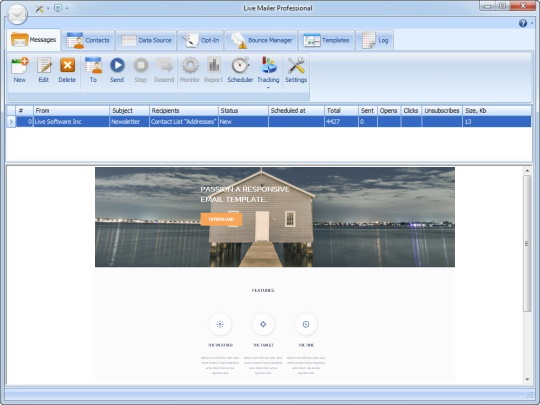Bulk Email Sending - Best Practices
Bulk email sending is the process of sending a large number of emails to a group of subscribers or customers at once. This type of email marketing can be a powerful tool for businesses looking to engage with their audience, promote their products or services, and drive conversions.
In this guide, we will cover the basics of bulk email sending, including the benefits, the types of emails that can be sent, and the best practices for successful campaigns. We will also discuss the important features to consider when choosing bulk email sending software.
Benefits of Bulk Email Sending
Bulk email sending offers several benefits for businesses looking to connect with their audience, including:
Cost-effective: Bulk email sending can be more cost-effective than traditional marketing channels, such as print or TV advertising.
Targeted: With the ability to segment subscribers and personalize content, businesses can create more targeted and relevant email campaigns.
Scalable: Bulk email sending software can handle large volumes of emails, making it a scalable option as businesses grow their subscriber list.
Measurable: By tracking metrics such as open rates and click-through rates, businesses can measure the effectiveness of their email campaigns and make adjustments as needed.
Convenient: With the ability to schedule emails in advance, businesses can automate their email marketing efforts and save time.
Types of Emails That Can Be Sent in Bulk
There are several types of emails that can be sent in bulk, including:
Newsletters: A regular newsletter can keep subscribers updated on news and events related to a business or industry.
Promotional emails: Promotional emails can be used to promote new products or services, or to offer discounts and special offers.
Transactional emails: Transactional emails, such as order confirmations or shipping notifications, can be sent automatically based on subscriber actions.
Event invitations: Invitations to events, such as webinars or in-person events, can be sent to subscribers to encourage attendance.
Survey or feedback requests: Email campaigns can also be used to gather feedback or conduct surveys among subscribers.
Choosing Bulk Email Sending Software
When choosing bulk email sending software, businesses should consider several important features, including:
Deliverability: The ability of the software to deliver emails to subscribers' inboxes and avoid being flagged as spam is crucial for the success of email campaigns.
List management: The ability to manage and segment subscriber lists, as well as handle bounced or unsubscribed emails, is important for keeping lists up-to-date and effective.
Personalization: The ability to personalize emails with subscriber names or other personalized content can help improve engagement and conversion rates.
Automation: The ability to automate email campaigns based on subscriber behavior or triggers can save time and resources.
Analytics: The ability to track and analyze email campaign metrics, such as open rates and click-through rates, can help businesses optimize their campaigns for better results.
Support: The availability of support and resources, such as tutorials or customer service, can help businesses getthe most out of the software and troubleshoot any issues that may arise.
Scalability: Businesses should consider whether the bulk email sending software can scale with their needs as their subscriber list grows and their email marketing efforts expand.
Security: Businesses should ensure that the bulk email sending software they choose has robust security features to protect subscriber data and prevent unauthorized access.
Reputation: Businesses should consider the reputation of the bulk email sending software provider, as well as the quality of their email delivery infrastructure, to ensure that emails are delivered reliably and with a high level of deliverability.
Compliance: Businesses should ensure that the bulk email sending software they choose is compliant with relevant regulations, such as the CAN-SPAM Act in the United States, to avoid potential legal issues.
Best Practices for Bulk Email Sending
In order to get the most out of bulk email sending software, businesses should follow some best practices to ensure their emails are engaging, effective, and compliant. These best practices include:
Build a quality email list: Businesses should focus on building a quality email list of subscribers who have opted-in to receive their emails, rather than purchasing lists or adding subscribers without their consent.
Segment subscribers: By segmenting subscribers based on criteria such as demographics or behavior, businesses can create more targeted and effective email campaigns.
Personalize emails: Personalizing emails with subscriber names or other personalized content can help improve engagement and conversion rates.
Test and optimize: By testing different elements of their email campaigns, such as subject lines or calls to action, businesses can optimize their campaigns for better results.
Monitor metrics: By monitoring metrics such as open rates and click-through rates, businesses can gain insights into the effectiveness of their email campaigns and make adjustments as needed.
Follow best practices: Businesses should follow best practices for email marketing, such as including an unsubscribe link and avoiding spam trigger words, to ensure compliance and improve deliverability.
Use automation wisely: While automation can save time and resources, businesses should use it wisely and ensure that automated emails are relevant and timely.
Bulk email sending is a powerful tool that can help businesses streamline their email marketing efforts and reach a larger audience with personalized and effective messages. By considering the features and considerations outlined in this guide, as well as following best practices for email marketing, businesses can leverage bulk email sending software to improve their email campaigns and achieve better results.

